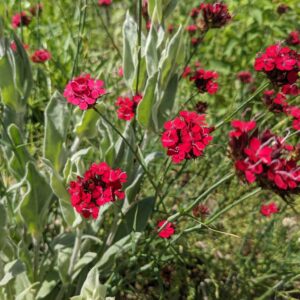Alpine, Rock, Miniature, Bonsai and Railroad Gardens
Showing 33–40 of 85 results
-
Dianthus cruentus Blood pink Z 5-9
Small but eye-catching carmine flowers held high on a leafless stem above basal foliage. Blooms in late spring-early summer
Small but eye-catching carmine flowers held high on a leafless stem above basal foliage. Blooms in late spring-early summer
Size: 2-3’ x 6-9”
Care: sun in moist well-drained soil
Native: Balkans
Wildlife Value: Attracts bees & butterfliesFirst described in Spic. Fl. Rumel. 1: 186 1843.
-
Dianthus deltoides Maiden pink Z 3-9
May - June and longer if deadhead bright pink or white
May – June and longer if deadhead, bright pink or white
Size: 8”x 12”
Care: Full sun well-drained soil, slightly alkaline
Native: Scotland to Norway
Awards: England’s Royal Horticultural Society Award of MeritDeltoides refers to the inverted V-shaped pocket at the base of the petals. D. deltoides 1st identified in 1671 by Swiss botanist Gaspard Bauhin (1560-1624) in Pinax theatri botanici, a landmark of botany, describing and classifying some 6,000 plants.
-
Dianthus sylvestris Woodland pink Z 4-8
Five, jagged-edged pink petals early summer on this sweet, fragrant flower.
Five, jagged-edged pink petals early summer on this sweet, fragrant flower.
Size: 10” x 10”
Care: full sun in dry, well-drained soil
Native: Moutains of Central & So. EuropeBailey wrote: “pretty perennial border plant.” Collected before 1787.
-
Draba aizoides Yellow Whitlow grass Z 3-8
Tiny yellow flowers in very early spring over succulent, evergreen cushions
OUT OF STOCK
Tiny yellow flowers in very early spring over succulent, evergreen cushions.
Size: 1” x 1”
Care: Full sun in well-drained soil.
Native: EuropeListed in Sanders’ Flower Garden, published in 1913 where it is described as “dwarf, compact-growing alpine, suitable for growing on old walls or on dry, sunny rockeries.” Draba is the classical Greek name for this plant – poultice said to remedy lesions on fingers
-
Dracocephalum botryoides Dragonhead Z 4-7
Fuzzy, grey, deeply divided foliage with baby pink blossoms in May-June
OUT OF STOCK
Fuzzy, grey, deeply divided foliage with baby pink blossoms in May-June
Size: 5” x 18”
Care: sun to part shade in well-drained soil
Native: Caucasus on rocky, stony slopes, and screes where it is now endangered.
Wildlife Value: provides nectar and pollen for bees1st described in 1812. Dracocephalum means “dragonhead,” referring the shape of the flower.
-
Erigeron aureus Alpine yellow fleabane Z 5-8
White hairs cover frosted-looking basil leaves making this worthy of any garden even without flowers, but then its school bus yellow daisies flower from spring through fall.
OUT OF STOCK
White hairs cover frosted-looking basil leaves making this worthy of any garden even without flowers, but then its school bus yellow daisies flower from spring through fall.
Size: 3-4” x 3”
Care: sun in moist well-drained to well-drained soil
Native: Cascade Mountains from Alberta to State of Washington
Wildlife Value: attracts bees, butterflies and birds1st described in literature in 1884.
-
Erigeron compositus Cutleaf daisy, Dwarf mountain fleabane Z 3-8
Miniature, cushion shaped plant with wooly grey leaves topped by small bluish, pink or white rays like a daisy with a yellow center. Flowers in June-July.
Miniature, cushion shaped plant with wooly grey leaves topped by small bluish, pink or white rays like a daisy with a yellow center. Flowers in June-July.
Size: 6” x 6-12”
Care: sun to part shade in well-drained soil.
Native: all of western No. America from prairies to alpine slopes.Erigeron comes from Greek er meaning “spring” and geron for “old man” due to some of these species having white downy hair like an old man.
Thompson Indians from British Columbia chewed on the plant then spit on sores to remedy skin ailments. They also made a decoction of the plant, mixed with any weeds for broken bones. Collected by Meriwether Lewis in late spring 1806 near today’s Lewiston Idaho. Erigeron comes from Greek er meaning “spring” and geron for “old man” due to some of these species having white downy hair like an old man. -
Eryngium maritimum Sea holly Z 5-10
Round thistles turning steely blue in July-August atop silver colored, prickly bracts. Attractive ivy-shaped prickly foliage.
OUT OF STOCK
Round thistles turning steely blue in July-August atop silver colored, prickly bracts. Attractive ivy-shaped prickly foliage.
Size: 12" x 10" slowly spreads
Care: Full sun in well-drained soil.
Native: Seacoasts of Europe“Eryngium” is Greek for thistle. Anglo-Saxons prescribed Sea holly root to cure the king’s evil, serpent bites, broken bones, stiff necks and melancholy. Also considered an aphrodisiac and brought on “kissing comfits.” This was identified by Dioscorides in De Materica Medica for medicinal use around 70 A.D. Eryngium was described in Gerard’s Herball in 1597 for its uses:” old and aged people that are consumed and withered with age, and which want natural moisture (and also) amended the defects of nature in the younger,” William Robinson, father of the mixed perennial border, considered this plant “very pretty.”








